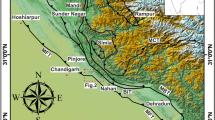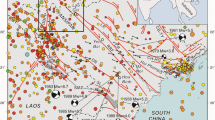Abstract
The current contribution presents aspects of the structural style and fault kinematics of the Rus Formation that expose at Jabal Hafit, Al Ain, United Arab Emirates. Although the major structure of Jabal Hafit is an anticlinal fold, fractures (joints and faults) are the prominent structure of the study area. The fractures can be interpreted as the distributed effect of deep-seated basement fault reactivation or to be as reactivation of deep-seated basement faults. These fractures were created during two main tectonic stress regimes. The first is a WNW–ESE S Hmax strike-slip stress regime, responsible for producing E–W to ESE–WNW joints and E–W dextral strike-slip and NNE–SSW reverse faults. This stress is interpreted to be post-Early Eocene in age and related to the second phase of thrusting in the Oman Mountains in the Miocene. The second stress regime is a NNE–SSW S Hmax transtensional (strike-slip extensive) stress regime that was responsible for N–S to NNE–SSW striking joints and NE–SW sinistral strike-slip and N–S normal faults. This regime is interpreted to be post-Middle Eocene in age. This stress was the response to the collision of the Arabian–Eurasian Plates which began during the Late Eocene and continues to the present day.













Similar content being viewed by others
References
Ali MY, Sirat M, Small J (2009) Integrated gravity and seismic investigation over the Jabal Hafit structure: implications for basement configuration of the frontal fold-and-thrust belt of the Northern Oman Mountains. J Pet Geol 32:21–38
Boote DRD, Mou D, Waite RI (1990) Structural evolution of the Suneinah Foreland, Central Oman Mountains. In: Roberston AHF, Searle MP, Ries AC (eds.). The geology and tectonics of the Oman Region. Geological Society of London, 49, 397–418 (special publication)
Coleman RG (1981) Tectonic setting for ophiolite obduction in Oman. J Geophys Res 86:2497–2508
Delvaux D (1993) The TENSOR program for paleostress reconstruction: examples from the East African and the Baikal rift zones. Terra Abstract. Abstract supplement, no. 1, to Terra Nova 5, 216
Delvaux D, Sperner B (2003) Stress tensor inversion from fault kinematic indicators and focal mechanism data: the TENSOR program. In: Nieuwland D (ed) New insights into structural interpretation and modeling, vol 212, Special publication. Geological Society of London, London, pp 75–100
Dunne LA, Manoogian PR, Pierini DF (1990) Structural style and domains of the Northern Oman Mountains (Oman and United Arab Emirates). In: Robertson AHF, Searle MP, Ries AC (eds) The geology and tectonics of the Oman region, vol 49, Special Publication. Geological Society of London, London, pp 375–386
Glennie KW, Boeuf MGA, Hughes Clark MW, Moody-Stuart M, Pilaar WFH, Reinhardt BM (1973) Late cretaceous nappes in Oman Mountains and their geologic evolution. Am Assoc Pet Geol Bull 57:5–27
Lacombe O, Bellahsen N, Mouthereau F (2011) Fracture patterns in the Zagros simply folded belt (Fars, Iran): constraints on early collisional tectonic history and role of basement faults. Geol Mag Cambridge University, pp 1–24
Lippard SJ, Skelton AW, Gass IG (1986) The ophiolite of Northern Oman. Geol Soc Lond Mem 11:1–178
Nolan SC, Clissold BP, Smewing JD, Skelton PW (1986) Late Campanian to Tertiary palaeogeography of the Central and Northern Oman mountains. In: Symposium on the hydrocarbon potential on intense thrust zones. Ministry of Petroleum and Mineral Resources, UAE and OPEC, Kuwait, Abu Dhabi, 175–200
Noweir MA (2000) Back-thrust origin of the Hafit structure, Northern Oman Mountain Front, United Arab Emirates. Geo Arab 5:215–228
Noweir AM, Alsharhan AS (2000) Structural style and stratigraphy of the Huwayyah anticline: an example of an Al-Ain tertiary fold, Northern Oman Mountains. Geo Arab 5(3):387–402
Noweir AM, Eloutefi NS (1997) The structural and stratigraphy of Jabal Malaqet Jabal Mundassa area, Southeast Al-Ain, Northern Oman Mountains, United Arab Emirates. N Jahrb Geol Palaontol (Abh) 204:263–284
Robertson AHF, Kemp AES, Rex DC, Blome CD (1990) Sedimentary and structural evolution of a continental margin transform lineaments: the Hatta zone, Northern Oman Mountains. In: Reberston AHF, Searle MP, Ries AC (Eds.). The geology and tectonics of the Oman region. Geological Society of London, 49, 285–305 (Special Publication)
Searle MP (1985) Sequence of thrusting and the origin of culminations in the northern and central Oman Mountains. J Struct Geol 7:129–143
Searle MP, Ali MY (2009) Structural and tectonic evolution of the Jabal Dumeini–Al Ain–Buraimi region, northern Oman and eastern United Arab Emirates. Geo Arab 14:115–142
Searle MP, James NP, Calon TJ, Smewing JD (1983) Sedimentological and structural evolution of the Arabian Continental Margin in the Musandam Mountains and Dibba zone, United Arab Emirates. Geol Soc Am Bull 94:1381–1400
Searle MP, Cooper DJW, Watts KF (1990) Structural of the Jebel Sumeini Jebel Ghawil area, northern Oman. In: Robertson AHF, Searle MP, Ries AC (Eds). The geology and tectonics of the Oman region. Geological Society of London, Special Publication no. 49, 361–174
Sirat M, Salman MS, Bella S (2007) Fracturing mechanism and fracture system analysis of fractured carbonate reservoir from Abu Dhabi, UAE. SPE/EAGE Reservoir Characterization and Simulation Conference, 28–31 October 2007, Abu Dhabi, UAE
Warrak M (1996) Origin of the Hafiat structure: implications for timing the Tertiary deformation in the Northern Oman Mountains. J Struct Geol 18:803–818
Zaineldeen U (2011) Paleostress reconstructions of Jabal Hafit structures, Southeast of Al Ain City, United Arab Emirates (UAE). J Afr Earth Sci 59:323–335
Zaineldeen U, Fowler A (2007) Post–Early Eocene folding and faulting at Jabal Hafit, Southeast of Al Ain City, United Arab Emirates. In: Second International Conference of the Tethys. Cairo University, 27–34
Acknowledgments
The authors would like to express their thanks to Dr. Othman Abdelghany who kindly assisted in the field mapping and with fossil identifications.
Author information
Authors and Affiliations
Corresponding author
Rights and permissions
About this article
Cite this article
Zaineldeen, U., Fowler, AR. Structural style and fault kinematics of the Lower Eocene Rus Formation at Jabal Hafit area, Al Ain, United Arab Emirates (UAE). Arab J Geosci 7, 1115–1125 (2014). https://doi.org/10.1007/s12517-013-0908-3
Received:
Accepted:
Published:
Issue Date:
DOI: https://doi.org/10.1007/s12517-013-0908-3




